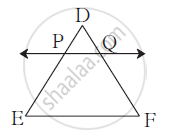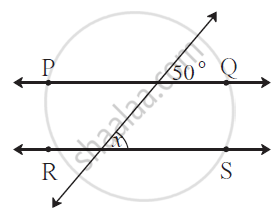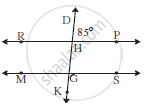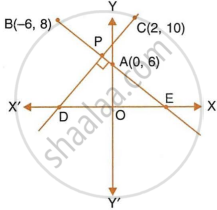Advertisements
Advertisements
प्रश्न
Verify that points P(–2, 2), Q(2, 2) and R(2, 7) are vertices of a right angled triangle.
उत्तर
Distance between two points = `sqrt((x_2 - x_1)^2 + (y_2 - y_1)^2)`
By distance formula,
`"PQ" = sqrt([2 - (-2)]^2 + (2 - 2)^2)`
`"PQ" = sqrt((2 + 2)^2 + (0)^2)`
`"PQ" = sqrt((4)^2)`
PQ = 4 ...(i)
`"QR" = sqrt((2 - 2)^2 + (7 - 2)^2)`
`"QR" = sqrt((0)^2 + (5)^2)`
`"QR" = sqrt((5)^2)`
QR = 5 ...(ii)
`"PR" = sqrt([2 - (-2)]^2 + (7 - 2)^2)`
`"PR" = sqrt((2 + 2)^2 + (5)^2)`
`"PR" = sqrt((4)^2 + (5)^2)`
`"PR" = sqrt(16 + 25)`
`"PR" = sqrt(41)`
Now, PR2 = `(sqrt(41))^2` = 41 ...(iii)
From (i) and (ii),
∴ PQ2 + QR2 = 42 + 52 = 16 + 25 = 41
∴ PR2 = PQ2 + QR2 ...[From (iii)]
∴ ΔPQR is a right angled triangle. ...[Converse of Pythagoras theorem]
∴ Point P, Q, and R are the vertices of a right angled triangle.
APPEARS IN
संबंधित प्रश्न
In ΔABC, A(3, 5), B(7, 8) and C(1, –10). Find the equation of the median through A.
Given 3x + 2y + 4 = 0
(i) express the equation in the form y = mx + c
(ii) Find the slope and y-intercept of the line 3x + 2y + 4 = 0
Find the slope and y-intercept of the line:
y = 4
Find the slope and y-intercept of the line:
ax – by = 0
Is the line 3x + 4y + 7 = 0 perpendicular to the line 28x – 21y + 50 = 0?
Find the equation of the line passing through (−2, 1) and perpendicular to 4x + 5y = 6.
The line 4x − 3y + 12 = 0 meets x-axis at A. Write the co-ordinates of A. Determine the equation of the line through A and perpendicular to 4x – 3y + 12 = 0.
Find the equation of the line which is perpendicular to the line `x/a - y/b = 1` at the point where this line meets y-axis.
Find the point on the X–axis which is equidistant from A(–3, 4) and B(1, –4).

In Δ DEF, line PQ || side EF, If DP = 2.4,
PE = 7.2, DQ = 1 then find QF.
In the figure, line PQ || line RS. Using the information given
in the figure find the value of x.


In the adjoining figure line RP ||line MS , line DK is a transversal . If ∠DHP = 85° find ∠RHG and ∠HGS.
In the given figure, line AB meets y-axis at point A. Line through C(2, 10) and D intersects line AB at right angle at point P. Find:

- equation of line AB.
- equation of line CD.
- co-ordinates of points E and D.
A line through point P(4, 3) meets x-axis at point A and the y-axis at point B. If BP is double of PA, find the equation of AB.
Find the equation of the line through the points A(–1, 3) and B(0, 2). Hence, show that the point A, B and C(1, 1) are collinear.
Three vertices of a parallelogram ABCD taken in order are A(3, 6), B(5, 10) and C(3, 2), find:
- the co-ordinates of the fourth vertex D.
- length of diagonal BD.
- equation of side AB of the parallelogram ABCD.
If (4,-3) is a point on line 5x +8y = c, find the value of c.
